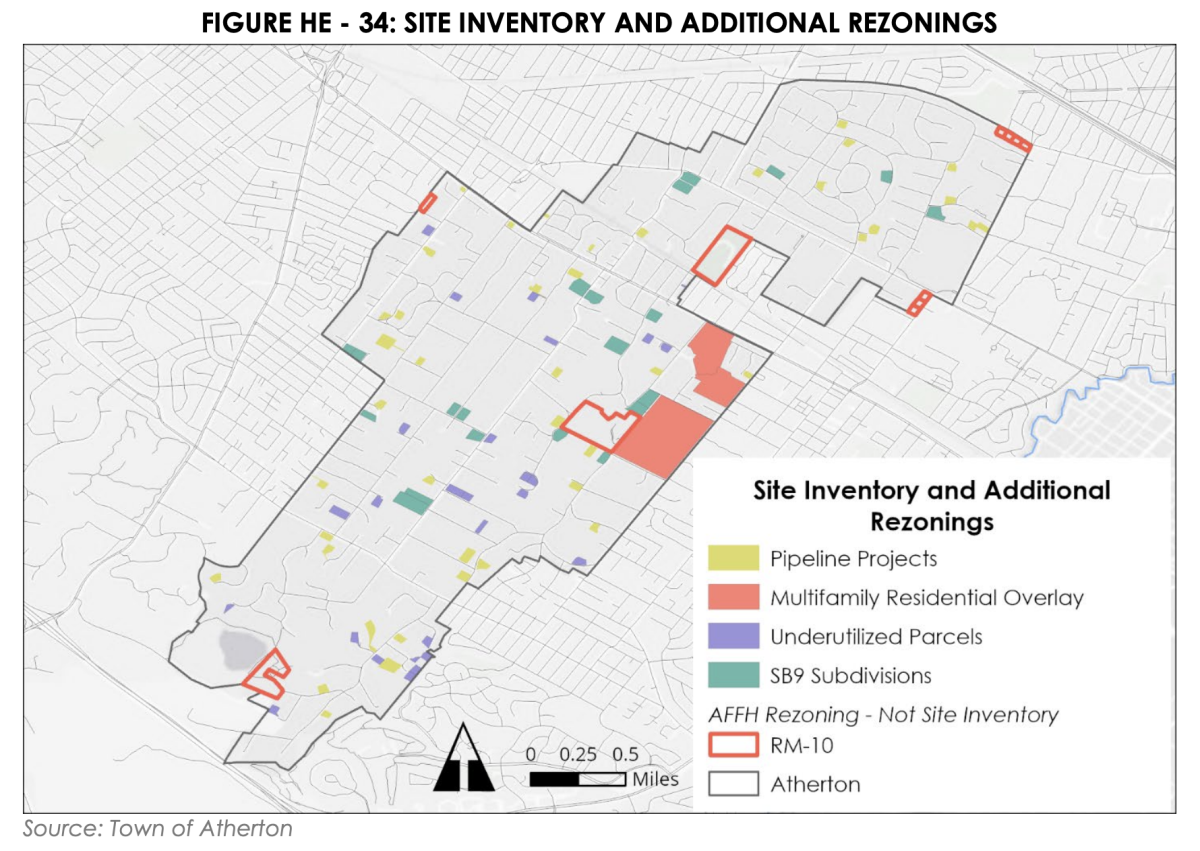Atherton city leaders, desperate to meet state housing mandates, voted in October to rezone Menlo School’s two primary parking lots — along with multiple other sites throughout the city — to allow for the construction of multifamily housing.
The two multifamily overlay sites — areas that are being rezoned to support denser multifamily housing — on Menlo’s campus allow for 20 housing units per acre, significantly higher than the city’s current one-unit-per-acre rule. Both are on parking lots — one in the southeast parking lot (the student lot alongside Valparaiso), and the other in the southwest parking lot (the teacher lot also next to Valparaiso, on the side of the Middle School).
A multifamily housing overlay does not guarantee the construction of apartment buildings or other dense housing; rather, it alters the zoning of areas to permit development if the landowner chooses to pursue it with their own funding.
Head of School Healy doesn’t believe that on-campus housing is a top priority for Menlo. “I have no current plans to build this,” he said. “I think just about the priorities of the school. If you asked me today, I would say financial aid, teacher and staff salaries and housing as a third element to that. […] [The renovation of] Cartan [Field] is the only physical project that we still have left on our campus that we need to do.”
According to Healy, constructing housing in the lots would be very expensive, and he is unsure if teachers would be interested in living there. “We’ll be asking [our employees about their interest] in a survey,” Healy said.
Three additional overlays were drawn over Menlo College’s campus, consisting of the O’Brien Lot (which is across from Cartan Field), an administrative building and the site of World War II barracks. According to Healy and Atherton’s Housing Element, Menlo College has shown interest in developing these areas but does not currently have the funds to do so. Another site is near the Oakwood Retirement Center at Sacred Heart. These overlays vary from allowing 20 to 40 units per acre.
These zoning changes are part of Atherton’s most recent housing element, a state-mandated plan based on the Regional Housing Needs Allocation (RHNA) program that helps address California’s housing crisis.
New housing elements are required every eight years. Atherton’s old 2023-31 plan heavily relied on Accessory Dwelling Units (ADU) to build the 348 units; however, according to the city, the California Department of Housing and Community Development wanted multifamily housing to be added to the plan before they would approve it.
Atherton had a town council meeting on Oct. 16, 2024, to discuss the latest version of the plan before its due date that night. The city is planning for 433 units to ensure it meets the sixth RHNA cycle between 2023 and 2031: 52 from pipeline projects, 208 from ADUs, 96 through multifamily housing overlays, 29 through underutilized parcels and 48 via Senate Bill 9 (SB 9) subdivisions.
Pipeline projects include new single-family houses and ADUs that have been constructed since 2022 or are currently under construction. The multifamily zoning overlays are six sites on private schools in the city. Underutilized parcels are empty plots of land. SB 9 is a 2021 law that allows homeowners to split their lots, and Atherton identified large lots that could be divided into two parcels.
The shift to permit multifamily housing in the primarily single-family zoned city would drastically change Atherton, which is home to just over 7,000 people and is the most expensive zip code in the nation, according to Forbes.
There are other single-family homes throughout the city that were rezoned to allow up to 10 units per acre, though these changes were not related to the city’s housing element.
During public comment on the Oct. 16 meeting, many residents objected to the new zoning overlays and the housing element in general. “We asked you to preserve our bucolic appearance, try to get buildings that look kind of like Atherton does today and try to preserve our values and our privacy,” Atherton resident Carol Flaherty said. “I don’t see where [the plan] keeps our town looking like we thought.”
Warren Jenson, another city resident, felt Athertonians weren’t being listened to. “There were several things mentioned very early on in the meeting. The first thing was: do the right thing. The second was: listen to your constituents. And I think you’re hearing loud and clear that this is not the right thing, nor is it […] your constituents that want this done,” Jenson said.
This reaction is not new. According to The Palo Alto Daily Post, famous couples and Atherton residents Stephen and Ayesha Curry, along with Marc Andreessen and Laura Arrillaga-Andreessen, objected to earlier versions of the town’s housing plan. Arrillaga-Andreessen’s late father, John Arrillaga, played a large part in building Silicon Valley and Menlo School.
Healy, who lives on school-owned property in Atherton, has a different perspective. “We should have affordable housing in every town in California,” he said. “It’s not good […] if people who are middle-class teachers and firemen and police can’t live where they work.”









